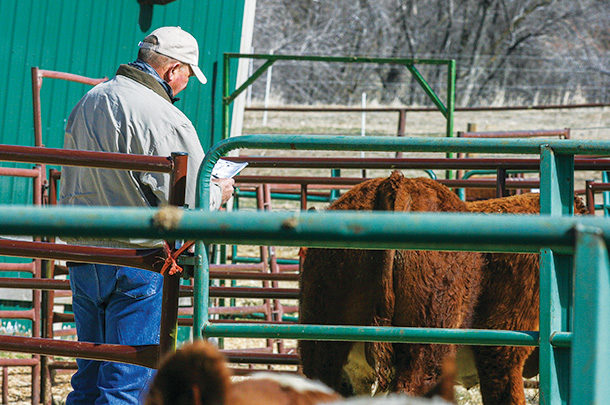As many producers are coming out of calving season, or are right in the middle of it, we need to start preparing for the next phase of the production system. Specifically, we should be preparing for breeding season.
Preparing for breeding season includes everything from ensuring our cows are in good enough condition to continue raising a calf while still rebreeding, to locating new genetics via bulls or semen that we want to incorporate into our herds. Incorporating new bulls into our herds has the potential to make the most change because the bull integrates his genetics into multiple offspring every generation. As such, we must put in some prep work to ensure that we get the proper bulls we need to improve our cow herds.
1. Evaluate herd data and initial evaluation of calf crop.
Herd historical data is valuable when making bull purchases. This data, if collected correctly, gives the producer an idea of where potential improvements in the cow herd need to be made. This can range from traits like cow size, udder structure, feet and legs and, subsequently, the quality of the calf crop. Additionally, when we buy bulls, our calf crop is already on the ground. This gives us an initial opportunity to evaluate last year's bulls’ contribution to our salable products and potential replacements. For example, maybe we want to increase calving ease, and perhaps we want a different looking calf. Our herd data and initial evaluation of our calf crop will provide information on the type of bull we are looking for and the trait levels we desire.
2. Establish trait levels for all the traits you want to improve in your operation.
Current bull sale catalogs provide a large amount of information to purchase a bull. However, after evaluating their herds, producers should know what they want to improve and what traits they want to maintain. First, producers must establish what genetic potential traits are important to their operations. This can be accomplished by ranking bulls based on their expected progeny difference (EPDs) and performance data for all crucial traits. This allows producers to maintain important traits while still selecting adequate levels of genetic potential for traits that need improvement.
3. Evaluate offerings from multiple bull sales.
Evaluating bulls from multiple sales may provide producers a better opportunity to find the bull or bulls that have the characteristics to address any issues or make the desired improvement in their herd. Additionally, the advent of internet or video sales has provided producers a valuable resource to evaluate and possibly own bulls they would have never had the opportunity to incorporate into their herds. Evaluating multiple sales may allow producers a better opportunity to buy what they need rather than what is simply available.
4. Establish a budget and determine what you can pay.
Establishing a budget and determining the return on investment of a bull is crucial before purchasing. Prior to a bull sale, rank your bulls and assign a budget to each bull. Determine the maximum you are willing to pay for each individual and your overall budget to fill your bull battery for the year. You must also evaluate how you justify paying that amount for the bull. For example, does he have the potential to significantly address issues in your herd? Is he going to increase efficiency in his daughters, or will he significantly increase your weaning weights? Whatever value is assigned to him, make sure he can make a change that has a good return on investment to justify his purchase price.
5. Determine how you're getting the bull from the sale to your operation.
As previously stated, internet and video sales have provided an excellent opportunity to incorporate bulls we may have never been able to incorporate into our herds. However, this also creates another step in the process as these sales may be a good distance away. If you are going to haul your bulls, you have already addressed this issue. If you are buying over the internet, you need to talk with the bull sale operators to make arrangements to get the bull from the sale to your operation. You must also include this transportation cost into your budget to help you stay on track when purchasing.
Summary
The process of bull buying can be exciting and provides us an excellent opportunity to incorporate new genetics into our herds. However, a little prep work will help us more accurately select a bull that will improve our herds and match our production goals and resources.








